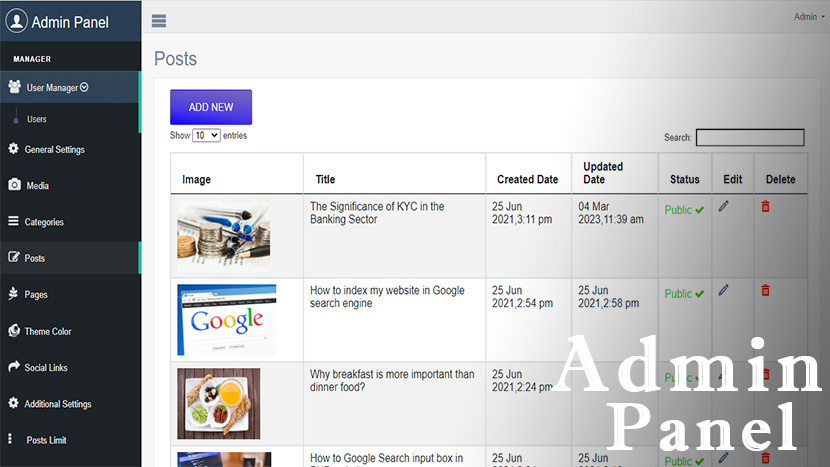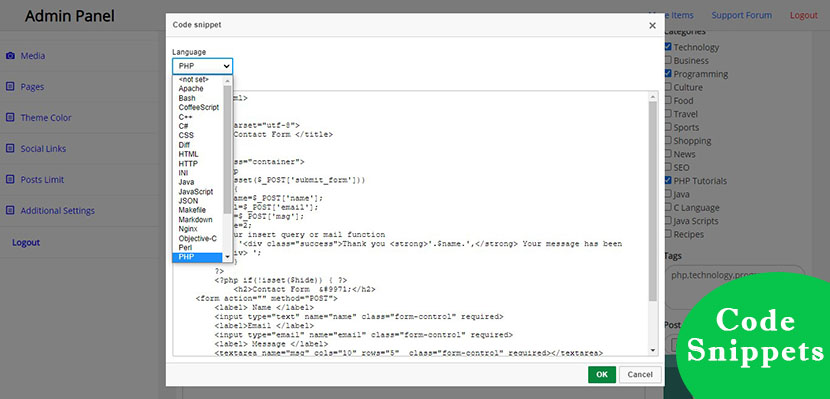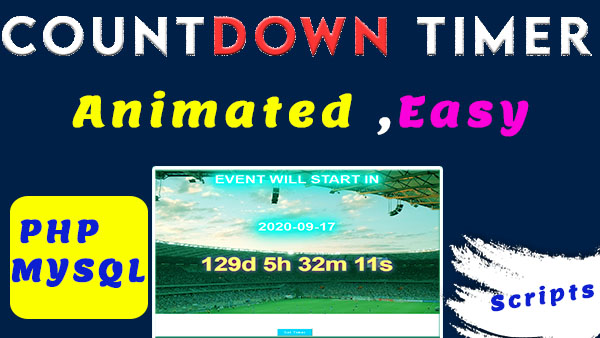Modern blog CMS in PHP with MYSQL database | PHP blog scripts

The modern blog contains the latest features and a lightweight structure. We have designed and developed a complete modern blog in PHP and MYSQL databases. In this blog CMS (Content management system), we have made three column structure using bootstrap responsive CSS classes. This is a complete blog CMS in PHP programming which can be used for your blogging and easier content management system. We have designed this blog with PHP, Bootstrap, JS, AJAX, and MYSQL database. If you are looking for a blog in PHP with an MYSQL database then It will be grateful to you. A blog system is used to share creativity in the world. if your blog is not faster (Lightweight) then you will get good traffic. That’s why we have designed a blog in PHP programming and an MYSQL database with very light files.
We have designed and developed the most essential features in this PHP web application.









Let’s talk about features –
Features of the blog in PHP and MYSQL database: –
1. Designed and Responsive blog in PHP –
The design of the blog should be attractive and very lightweight. We have designed a blog with very lightweight CSS, and JS files to reduce the size of the page. The blog page opens faster than the click process.PHP blog has more beneficial if you see the blog speed. We have designed a blog using bootstrap to make the blog responsive. You can open this PHP blog on any device like- Desktop, mobile, tables, and small or big size screens.
2. Three-column blog CMS in PHP | 3-column blog –
As you know, three-column blogs are more popular than simple blogs. We have designed three column blog using bootstrap responsive classes.
3. Blog top and sticky Primary header –
We have designed two headers. The first header is for pages and the second header is for blog categories in PHP. We fetch and display categories and subcategories using PHP and MYSQL database.
4. Posts with All posts page –
Posts are visible on the Home page or if you want to check all posts then click on view all and check all posts page with pagination.
5. Categories and Subcategories –
Categories are more important to separate content into different topics. We have designed PHP categories and subcategories system using PHP and MYSQL database. Some blog categories are on the home page and all blog categories are on the categories page with pagination.
6. Recent posts-
You can check recent posts on the home page and in the sidebar.
7. Blog top posts in PHP | Trending posts -
Top posts are known as trending posts on the blog portal. We have designed a function to display top (trending ) posts on the home page and in the footer.
8. Blog tags in PHP –
Tags play an important role in blogs. We have created a tags system in PHP with an MYSQL database.
9. Blog post viewer –
The blog post viewer should be readable and attractive.We have designed a blog viewer with attractive designs.
10. Blog Social Share buttons (Icons) using PHP –
Social share buttons (Icons) are used to increase SEO ranking. Anyone can share posts on social sites.
11. Custom blog link copier –
We have created a customer link copier using PHP and JS. Viewers can copy by clicking on copy button and can share on any platform and app.
12. Blog Related posts using PHP match –
The related post module is used to show the related posts to the content. If you open any post, you will see a related post below the whole content of the current blog post.
13. Admin panel –
We have developed an admin panel for the customization of blog posts and pages.
14. Blog User management-
Admin can new user and edit or delete the user.
15. Blog Posts –
Create a new post, add edit posts and delete posts. Admin can upload images, link images, design text, align text, justify text, colors, and more using a text editor.
16. Embed video –
This is another feature of the blog - Admin can embed Youtube videos to display and play videos.
17. Blog categories and subcategories –
Admin can create new blog categories and sub-categories. We have designed and developed blog categories and sub-categories using PHP tree structure and MYSQL database.
18. Media –
Admin can upload, delete and reuse images.
19. Blog page management –
Admin can create pages with a text editor, edit pages and delete pages.
20. Blog Theme color customizer –
This is another advanced feature for a PHP blog. Admin can change the theme color.
21. Social Links –
Admin can set social links.
22. Post Limit –
A post limit is another advanced feature of a blog using PHP and MYSQL databases. Admin can set the limit for Recent Posts (Sidebar), Top Posts (Sidebar), Related Posts, Pages (Footer), Categories (Footer), Top posts (Footer), Posts (Home page ), Categories(Home), Recent Posts (Home), Top Posts (Home).
23. Blog Additional Settings in PHP –
The name additional indicates that you can add extra CSS, CSS link, js, js link, or ads code inside the head, header, below title left sidebar, right sidebar, below content, footer, and before closing body tag.
24 . Blog General settings –
The general setting is an essential part to start blogging on this PHP blog web application. Here, you can change the blog title, URL, about, tags for SEO purposes, contact email to receive emails, etc.
25. SEO-friendly blog in PHP –
We have developed this blog with SEO-friendly URLs like – Blog post URLs, blog categories URLs, blog tags URLs, etc.
We have developed meta properties like – descriptions, tags, URLs, types, preview images on social sites, etc for SEO-friendly blog posts in PHP.
26. Sitemap –
The sitemap is used to link your site to search engines. We have developed a sitemap.xml file. You can submit to any search engine to index blog pages.
27. Code snippet –
The code snippet is another feature of the blog by which programmers can display highlighted code inside the post.
28 . Blog Searching system –
The search system is the most important part of a modern blog that helps the visitor to find related content. Visitors can search and find keywords related to blog posts easily.
28. 404 page –
If the page is not found.
29. No coding required –
If you don’t have any coding skills or you are not from a coding background then don’t worry. This is really simple to install and use without any coding.
30. Simple installer –
As we have discussed above this is a modern blog web application in PHP, you can install buy simple form. Just fill out the details and done.
You will get support for installation also.
31. Support features –
This PHP web application comes with lifetime support for any issues and installation.
32. Upgrade features-
When we upgrade it, you will download the upgraded version for free.
We have discussed all major features of Blog in PHP and MYSQL database.
| Version 2.1 (Latest Updated) |
|---|
| Tags input plugin |
| SEO-friendly custom slug |
| Strong effect fixed |
| Feature image remove button |
| Category image remove button |
| Support PHP 7.4 and PHP 8 + Versions |
| Version 2.0 |
|---|
| New Advance Admin panel |
| Fixed Page URL - Removed Page word |
| Paragraph p font size increased |
| Media changed (Upload all formats) |
| Whatsapp and mail share icons |
| Category two-column grid view in mobile |
| Highest security level |
|
Super fast speed (Lightweight files) |
| Added canonical tag - Page link |
| All meta tags (Fully SEO friendly) |
| Version 1.0 |
|---|
| Initial Release .. |
Most Related
 Live Chat
Live Chat
Hello! How can we assist you today?










